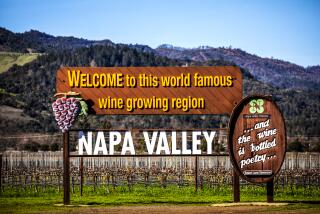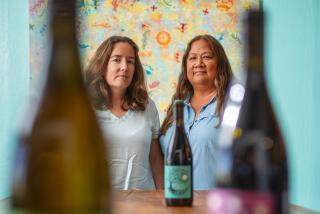Falling for the Niagara Peninsula’s Wine Route
NIAGARA-ON-THE-LAKE, Canada — Add wine to the already numerous inducements for visiting this lakeside hamlet on the Canadian side of the Niagara River’s mouth in Ontario province.
The Niagara Peninsula has long produced wine from native grapes that, at best, yield acceptable aperitif wines. But in little more than a decade, some small wineries have taken root in this splendidly situated region whose climate is moderated by Lake Ontario to the north and sheltered from cold continental blasts by a prominent ridge, the Niagara Escarpment, to the south.
And the welcome mat is out to visitors who wend their way along the newly posted, picturesque Wine Route to sample the new premium bottlings. Since last year’s harvest, these can now be labeled with their own Niagara Peninsula designation, Canada’s first wine appellation.
Happily for tourists, the Wine Route also leads to a sampling of the region’s other pleasures. Prominent among these is Niagara-on-the-Lake, a town of barely 12,000 that offers tree-lined lanes, neatly maintained homes, a lake-side golf course and comfortably appointed, reasonably priced country inns.
This bucolic understatement provides a welcome contrast to the garish city of Niagara Falls, about a dozen miles upstream. Yet the town’s Queen Street offers just enough shops for browsing among woolens, antiques and porcelains, and a clock tower separating traffic in front of the 18th-Century courthouse that, in 1792, served briefly as Capitol of Upper Canada, now Ontario province.
As it approaches the river, the Wine Route passes in front of the contemporary wood-and-glass theater that is home to Niagara-on-the-Lake’s annual George Bernard Shaw Festival, which runs from Easter to mid-October, then skirts Ft. George (named for one of the English kings) a key British bastion in the War of 1812. America’s counterpart, Ft. Niagara, is visible across the river’s mouth in New York.
At the broad river, the Wine Route joins Niagara Falls Parkway and an adjacent bike path that meanders along the steep, forested banks before breaking west to crisscross orchards and vineyards on its way to complete the loop at historic Welland Canal. The canal’s locks enable freighters to bypass Niagara Falls and find safe passage between Lakes Erie and Ontario.
For anyone who recalls Napa Valley, or for that matter Sonoma, before wine and wine tourism became big business, Niagara-on-the-Lake represents a welcome step backward. On this peninsula, which encompasses a dozen municipalities, about as many wineries have begun to offer samples of their production.
In terms of quality and California prices, the region provides some interesting bargains, including a Pinot noir from Pelee Island in Lake Erie, Canada’s southernmost point, which retailed at Ontario’s government-controled retail store in Niagara-on-the-Lake for about $7.
This new premium-wine industry traces its brief life to the day in 1973 when a young local vineyard supplier named Donald Ziraldo found himself defending the foxy-sweet wines produced from native Niagara grape varieties against the outspoken criticism of a customer, Karl Kaiser, a recent emigrant from Austria.
Kaiser’s response to the mediocre wine he had found in his adopted country was to make his own, and he eventually uncorked a bottle of dry rose to show what could be done under the peninsula’s microclimate.
Ziraldo recalled his amazement. “You made this from those?” he asked.
That tasting was to lead to the formation of Inniskillin Wines (in memory of an Irish military unit that fought on the peninsula during the War of 1812). The goal was to stay small and produce only fine wines. Today these include such Burgundian varieties as Pinot noir and Chardonnay, Riesling and Gewurtztraminer worthy of Alsace, as well as rarely encountered wines from French-developed hybrids that sport such unfamiliar names as Marechal Foch, Baco Noir and Vidal.
Inniskillin produced 112,000 cases of mostly premium wine last year, though no more than 1,000 cases found their way into this country. But Inniskillin, which now owns prize Napa Valley vineyards at Rutherford, intends to begin changing that.
Along with neighboring wineries, including Reif, German-owned Hillebrand and Chateau des Charmes, supported by the provincial government, the Canadians last month made their first marketing foray into New York--which one importer characterized as “the epicenter of the wine world.”
But for now these wines remain a largely local secret, but it is one that the wineries are eager to make better known. Thus, most offer free tours and samples at little or no charge. Their warm, personalized reception contrasts with the increasingly impersonal experience one encounters in Napa Valley, where wine makers find themselves overrun by tourists and tour buses (even a new Wine Train), and where demand for tourist facilities and housing competes with demand for vineyards.
Lodging is available all year at Niagara-on-the-Lake and along the lake to the west in bustling St. Catharines. Rooms fill fast each year during the Shaw Festival and on holidays, but help is available, toll-free, from the Ontario Ministry of Tourism and Recreation. Call toll-free (800) 268-3735.
The area has a wide selection of reasonably priced lodging. The top of the line is represented by the Prince of Wales, where winter rates run from $94 for a single to $200 for a suite.
Adjacent to the lake-front golf course is the Oban Inn, the 19th-Century residence of a shoe manufacturer, where rates range from $70 to $150 and afternoon tea is available on a glass-enclosed terrace.
A best buy, just down Picton Street from the Prince of Wales, is the Moffat Inn, established as a hostelry in 1835. It offers antique-appointed rooms from $49 to $90 in winter and from $75 to $95 next summer.
Prince of Wales, 6 Picton St., Niagara-on-the-Lake, Ont., Canada L05 1J0; (800) 263-2452.
Oban Inn, 160 Front St., Box 94, Niagara-on-the-Lake; (416) 468-2165.
Moffat Inn, 60 Picton St., P.O. Box 578, Niagara-on-the-Lake; (416) 468-4116.
For more information, contact the Ontario Tourism Office, 700 S. Flower St., Los Angeles 90017, or call (213) 622-4302.
More to Read
Sign up for The Wild
We’ll help you find the best places to hike, bike and run, as well as the perfect silent spots for meditation and yoga.
You may occasionally receive promotional content from the Los Angeles Times.






